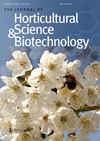Morphological changes of Dioscorea trifida cv. Short Neck Yampie and D. cayenensis cv. Round Leaf Yellow Yam linked to the number and size of harvested tubers
IF 2.1
4区 农林科学
Q2 HORTICULTURE
Journal of Horticultural Science & Biotechnology
Pub Date : 1999-01-01
DOI:10.1080/14620316.1999.11511148
引用次数: 4
Abstract
SummarySuccessful use of tissue culture to propagate Dioscorea spp. depends on maximizing subsequent growth in vivo. This paper describes the growth of in vitro plantlets of the Jamaican yams D. trifida L. cv. Short Neck Yampie (SNY) and D. cayenensis Lam. cv. Round Leaf Yellow Yam (RLYY) after transfer to in vivo conditions, from day zero (day of transfer) to harvest of the first generation tubers at 314 d, and sprouting of these tubers. As the SNY and RLYY plants grew in vivo, abrupt changes occurred in the type of shoot (changed from type I to type II) and underground organ (from primary nodal complex to tuber), and in the rates of stem and root growth. Gradual changes occurred in the number of roots. The first observable morphological feature of the SNY and RLYY plants to change was the shoot tip. This changed from a lateral position at the node at the base of a terminal leaf (lateral tip), to the shoot apex (apical tip). It is suggested that the change in shoot tip position and associated features ma...山药的形态变化。短颈山猫和卡延山猫。圆形叶子黄色山药与收获块茎的数量和大小有关
组织培养繁殖薯蓣属植物的成功与否取决于其在体内生长的最大化。本文报道了牙买加山药D. trifida L. cv离体植株的生长情况。短颈山猫(SNY)与卡延山猫(d.c ayenensis Lam)。简历。圆叶黄山药(RLYY)转移到体内条件后,从第0天(转移日)到第314天收获第一代块茎,并发芽。随着SNY和RLYY植株在体内的生长,茎部类型(由I型变为II型)和地下器官类型(由初生节复合体变为块茎)以及茎和根的生长速率都发生了突变。根的数量逐渐发生变化。SNY和RLYY植株变化的第一个形态学特征是茎尖。这从在顶生叶基部的节(侧梢)的侧面位置改变到茎尖(尖尖)。结果表明,针尖位置的变化及其相关特征可能是造成这一现象的主要原因。
本文章由计算机程序翻译,如有差异,请以英文原文为准。
求助全文
约1分钟内获得全文
求助全文
来源期刊
CiteScore
3.90
自引率
5.30%
发文量
67
审稿时长
3 months
期刊介绍:
The Journal of Horticultural Science and Biotechnology is an international, peer-reviewed journal, which publishes original research contributions into the production, improvement and utilisation of horticultural crops. It aims to provide scientific knowledge of interest to those engaged in scientific research and the practice of horticulture. The scope of the journal includes studies on fruit and other perennial crops, vegetables and ornamentals grown in temperate or tropical regions and their use in commercial, amenity or urban horticulture. Papers, including reviews, that give new insights into plant and crop growth, yield, quality and response to the environment, are welcome, including those arising from technological innovation and developments in crop genome sequencing and other biotechnological advances.

 求助内容:
求助内容: 应助结果提醒方式:
应助结果提醒方式:


